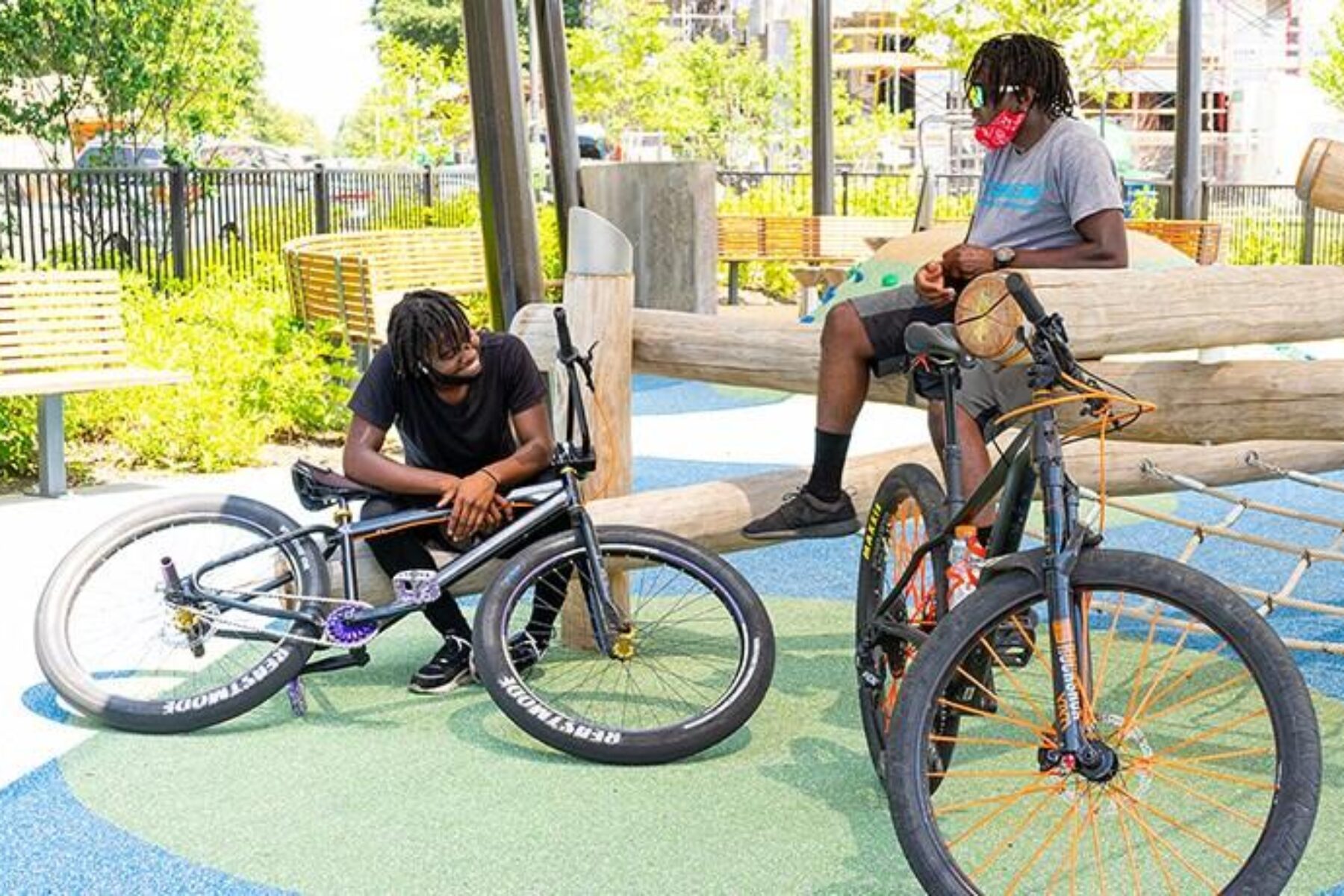Looking Back, With Gratitude, on a Year of Challenges and Triumphs for Trails

As 2020 draws to a close—a year of extreme changes and challenges—it is with incredible appreciation that we reflect on the collective impact of our movement across the country.
While the COVID-19 pandemic has altered our lives dramatically, it has also made clear just how vital trails are to people and places—serving as important space for health and wellness and providing safe outdoor access for millions of people.
This remarkable impact would not have been possible without the time, dedication and ingenuity of America’s trail builders and advocates, whose efforts brought so much impact to so many people.
As we look back, inspired and humbled, on just a few of the ways we galvanized the movement together in 2020—we do so with gratitude to all those who worked relentlessly to connect their communities, and the nation, by trail.
Connecting Millions of People to Safe Outdoor Spaces

With the COVID-19 pandemic, we’ve seen an unprecedented demand for trails, as people seek safe places to be outside in the midst of social distance mandates and stay-at-home orders, as well as forced closures—across the country—of many parks, playgrounds, recreation facilities, community centers and other social gathering spots. Trail use soared, initially spiking 200% nationwide on average over the same time last year, according to a study by RTC, and since then sustaining over the course of the pandemic at more than 50% higher than in previous years. These dramatic increases have underscored the critical need for open space—and have drawn stark attention to the lack of parks and trails in many communities.
In March, as Americans hunkered down, and automobile traffic decreased in many cities—RTC and partners launched a national effort calling on local elected leaders to take immediate action to close select streets and create more safe space for walking and bicycling. Over the past 10 months, we’ve engaged thousands of people, who’ve made it clear that they want more access to space where they can walk, bike and be active outside.
In response, more than 70 cities and towns have allocated streets for social distancing, with cities like Washington, D.C., Seattle and Oakland, among others, committing to long-term pilot programs that will look at how streets can be reimagined as spaces where people can be outdoors, separated from vehicle traffic. In Massachusetts, the state department of transportation committed stimulus dollars to support quick-build projects that would create outside space more quickly in more places in the state.
To promote careful and conscientious trail use—and engage the millions of new users flocking to trails and greenways—RTC has collaborated with trail and health experts across the United States, as well as more than 1,000 entities through the international #RecreateResponsibly campaign, to develop and distribute resources with the latest information on how to safely access trails and outdoor spaces, and the importance of taking care of these vital amenities during this difficult time period.
Additionally, TrailLink.com, RTC’s national trail-finder website and app, has served more than 10 million people nationwide seeking new and close-to-home places to walk, bike and be outdoors, further demonstrating the overwhelming demand for trails—and the continued need for national engagement around safe trail use.
Over the year, through our national “Trail Moments” initiative, we’ve captured thousands of stories from both new and tried-and-true trail users, who have let us know just how much trails have meant to them during the pandemic. Get to know some of these unique voices on our Trail Moments portal.
Share Your Trail Moment
Have you recently discovered trails, or are you a long-time trail enthusiast? Either way, we hope you’ll share your “Trail Moments”—and the stories of how trails have impacted your life during COVID-19. Take the survey below, or share using #TrailMoments on social media.
Access RTC’s COVID-19 Resources page for the latest expert-vetted tips and information on safe trail use and how to #RecreateResponsibly during the pandemic.
Creating New Trail Connections Across the Nation

This year, our eight TrailNation™ projects gained momentum across the country as funding wins and other milestones opened up new doors for impactful collaboration and connectivity. These trail networks have the potential to provide equitable access to trails for millions of people and generate significant economic and health opportunities in their areas.
In February, through the 2,700-mile Bay Area Trails Collaborative in California, we celebrated the opening of a 0.9-mile segment of the Cross Alameda Trail, a new vital walking and bicycling connector for the region.
In March, we stood alongside our regional partners in Cleveland to unveil a feasibility study for the 200 miles-plus Cleveland to Pittsburgh Corridor (C2P)—a key part of the Industrial Heartland Trails Coalition’s vision for a 1,500-mile trail network that will bring economic growth and improved quality of life across a four-state region.
In July, we saw the Capital Trails Coalition take a big step forward with the Metropolitan Washington Council of Governments’ passage of the National Capital Trail Network—a concept for a 1,400-mile trail network that expands upon the coalition’s vision to increase multiuse trails across D.C., Maryland and Virginia.

In early fall, RTC and partners in Wisconsin were ecstatic to receive more than $6.3 million in grants to six projects within the 700-mile Route of the Badger trail network that have the potential to unlock incredible opportunities for hundreds of thousands of people living in the Southeast Wisconsin.
In October, we announced the results of a new economic impact study on the Baltimore Greenway Trails Network, which found that the 35-mile developing project—which will link 75 neighborhoods—has the potential to generate millions of dollars in job growth, increased property values and health-care saving costs.
Related: Proof: Bike Paths are Good for the Local Economy | Streetsblog USA
In November, we celebrated alongside partners in Texas the opening of a 1.8-mile extension of the City of Brownsville’s Historic Battlefield Trail—the first exciting phase of a catalyst project within the Caracara Trails network, a 428-mile project that will ultimately deliver hundreds of millions of dollars in economic impact and health-care cost savings.
In the fall, RTC and partners in Wisconsin released a preliminary feasibility study for the 30th Street Corridor in Milwaukee, a developing project that would help create crucial connections for many historically underserved neighborhoods and potentially increase the number of city residents with access to trails by 700%.
A Visionary Federal Funding Bill for Trails and Active Transportation
As Congress and the White House worked this year to define the next major federal transportation bill, RTC collaborated with key partners and congressional staff to outline the components of a federal funding package that would be transformative to the nation—significantly increasing investments in trails, walking and biking, and creating a new program that would accelerate a connected active-transportation system for the nation.
With an eye on tackling critical issues—including the post-pandemic economic recovery and the climate change crisis—RTC’s vision includes bills that focus on maximizing the benefits of trails while investing in active transportation connectivity; growing America’s long-standing dedicated federal funding programs for trails, walking and bicycling; and providing increased funding for active transportation projects for our federal public lands.
In early summer, more than 170 organizations joined us in calling on Congress to support the Connecting America’s Active Transportation System Act (H.R.5696/S-3391), a visionary $500 million annual package that did much to elevate trails, and of which many elements were rolled into the U.S. House of Representative’s Moving Forward Act, passed in July of 2020.
Then in November, in the wake of presidential transition, RTC and PeopleForBikes publicly released a bold and visionary agenda for active transportation, with key elements that could help policymakers put Americans to work—and help building strategic connections among the nation’s trails and active transportation networks that could help unlock billions of dollars for the U.S. economy.
Related: Investing in the Transportation System America Needs | The Hill
RTC will continue to engage Congress in making this agenda a reality, and is inviting both organizations and individuals in supporting this critical effort for our nation’s trail systems.
Related: Four Easy Ways Biden Could Revolutionize Our Cycling Culture | Streetsblog USA
State Bike/Ped Initiatives Pass Across the Board
Support for trails at the state level was evident this year, as voters and legislatures demonstrated overwhelming support for innovative programming and legislation that could result in transformative public investments in trails and active transportation.
Highlights include:
- Legislation passed in September in California that exempts certain bike/ped and transit projects from bulky CEQA reviews and could accelerate high-priority projects across the state—including those within the 2,700-mile Bay Area Trails Collaborative footprint.
- The inaugural summit in September of the recently launched Indiana Legislative Trails Caucus—a bipartisan group of 25+ legislators committed to completing Indiana’s trail networks—including the state’s portion of the 3,700-mile Great American Rail-Trail.
- A $112 million parks bond—with a $12 million portion that includes trail eligibility—passed in Fairfax County, Virginia, in November, which could help support the buildout of local trails, including impactful projects within the footprint of the 800-mile Capital Trails Coalition.
- Renewal of the ECHO program in Volusia County, Florida, which has provided $1 million annually for vital trail projects in the state.
- Major transportation and transit funding measures in Austin and Denver that could support bike lane, trail and e-bike projects that promote active transportation while supporting climate change mitigation.
Great Strides for the Cross-Country Great American Rail-Trail

It is with a shared spirit of appreciation for all our Great American Rail-Trail™ partners, and a sense of pride, that we note the progress made this year for the development of the nation’s first cross-country multiuse trail—despite incredible challenges faced by our nation and our trail community.
In December, RTC and trail partners across the country celebrated our one-year anniversary for the Great American Rail-Trail and the incredible progress made in 2020.
In 2020, more than $4 million in public and private funds were secured for Great American projects—and 20+ miles of trails were completed, taking the overall total to 2,000+ miles.
In the spring, RTC joined the Iowa Natural Heritage Foundation and trail supporters to help rally legislative support for Iowa’s trail networks at an event at the Iowa State Capitol that drew attention to the benefits of Iowa trails—and the importance of programs like the Natural Resources and Outdoor Recreation Trust Fund for completing transformative projects like the Iowa River’s Edge Trail and the state’s portion of the Great American Rail-Trail. Created earlier that year by overwhelming state vote, the Trust Fund could provide as much as $171 million annually for outdoor and conservation projects.
Then in the summer, the Great American saw exciting progress in Indiana and Nebraska. In the Hoosier State, trail builders celebrated the opening of the first mile of the Veterans Memorial Trail in Hebron in June—and the opening of 3.4 miles of the Pennsy Greenway between Schererville and Munster in July. These two trail segments bring the total miles of existing trail along the Great American in Indiana to 116. In Nebraska, trail builders signed an easement agreement to create 5 miles of trail alongside an active corridor to help connect the Cowboy Recreation and Nature Trail into Chadron. A gateway trail for the Great American, the 321-mile developing Cowboy Trail is the longest rail-trail conversion in the country.
“This year has proven how vital projects like the Great American Rail-Trail are to the country. Millions of people have found their way outside on trails as a way to cope with the pandemic,” said Ryan Chao, president of RTC. “As the Great American … connects more towns, cities, states and regions, this infrastructure serves as the backbone of resilient communities.”

Donate
Everyone deserves access to safe ways to walk, bike, and be active outdoors.




